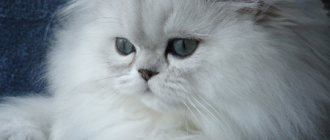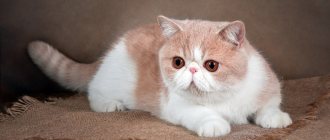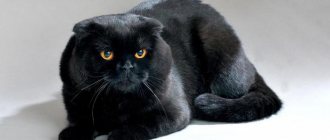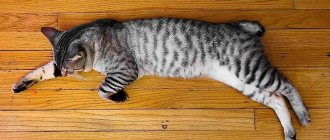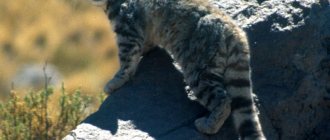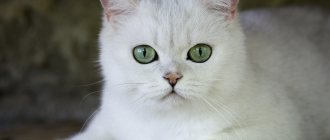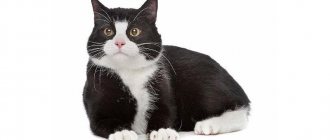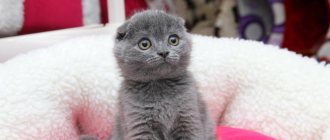British cats are famous for their variety of different coat and iris colors. Breeding representatives of the breed with different numbers of snow-white spots on their coats has become popular: bicolor cat, van, harlequin, tricolor. The main color of an animal's fur coat can be very different (black, chocolate, lilac, blue, etc.), and combinations of spots of various shapes are amazing.
Genetics and history of bicolor color
A bicolor cat is like this because it has a certain set of genes. The appearance of white spotting in a bicolor kitten is due to the S gene (the dominant form gives white spotting, the recessive form gives solid color). Therefore, bicolors can only be born from bicolors. Cats heterozygous for this gene (Ss) have a color from bicolor to solid (solid) with residual spots on the chest, groin and paws.
It is worth noting that the bicolor color and other colors with white have not yet been sufficiently studied - geneticists have several hypotheses regarding their formation. But these colors have been known since ancient times. Therefore, some felinologists who do not like bicolors call the color “yard” and “garbage”, because many street cats are bicolors. At the same time, to make a bicolor cat truly beautiful, breeders have to work hard. Therefore, in our opinion, a high-quality bicolor color can be called anything but garbage.
BRITISH CATS WITH WHITE: TYPES OF COLOR
British cats with white in the color coding are supplemented by the number 01 - van, 02 - harlequin, 03 - bicolor - this is the relationship between the white color in the color and its quantity. There are the following types of colors with white spotting:
- bicolor/van/harlequin classic;
- tortoiseshell tricolors (calico);
- bicolor/van/harlequin/tricolor tabby;
- bicolor/van/harlequin/smoky tricolors;
- bicolor/van/harlequin/tricolor color-point;
- mixed colors (bicolor tortoiseshell shaded, bicolor color-point veiled, etc.).
The eye color of the British in color with white is always golden (yellow).
PHOTO GALLERY WITH DIFFERENT COLOR OPTIONS WITH WHITE
| Photo: British cat black and white - black harlequin (black harlequin) BRI n 02 | British chocolate bicolor BRI b 03 | British kitten blue bicolor BRI a 03 |
| Photo: British kitten lilac bicolor BRI from 03 | Photo: British cat cinnamon bicolor BRI o 03 | Photo: British Fawn cat bicolor BRI p 03 |
| Photo: British red harlequin BRI d 02 | Photo: British cream bicolor BRI e 03 | Photo: British black and white – British kitten black van BRI n 01 |
| Photo: British black silver tabby bicolor Bri ns 22 03 |
| British tricolor cat - black and red tortoiseshell harlequin with white BRI f 02 |
| Photo: British cat lilac harlequin BRI d 02 | Photo: British cat blue van BRI a 01 | Photo: chocolate smoky bicolor BRI bs 03 |
| Photo: British kitten black and red tortoiseshell marbled bicolor BRI f 22 03 | Photo: British chocolate smoky color-point bicolor BRI bs 04 33 | Photo: British cinnamon color-point bicolor BRI o 04 33 |
COLOR OF BRITISH CAT BICOLOR (color code 03)
A British bicolor cat should be covered in white from 1/3 to 1/2 of the animal's color. The white color should be present from the British head in the form of a regular triangle, which begins on the forehead and diverges in both directions, touching the inner corners of the eyes. The collar and chest, the inside of the paws, and the belly should be white. The main color must be present on the head and back. The tail must be colored. There should be no white hairs in the main color (black, blue, lilac, etc.) - in this case, the color is rejected. The main color and white color must be clearly distinguished. The white spots are quite large, evenly distributed throughout the body. And, what is important, the overall color should look quite harmonious.
It must be said that sometimes bicolor British dogs do not always maintain an even white triangle on the head. Some white shift is allowed, but with clear boundaries. At least one ear must be painted in the main color.
Blue color with white British cats. Blue bicolor British
COLOR OF BRITISH CAT HARLEQUIN (color code 02)
The British Harlequin is also evenly distributed in color. The white color of the Harlequin British cat fills the color of approximately 5/6 of the coat color, the rest is colored color. The colored part of the color is present on the head, front legs, back, and tail.
Head: at least one colored spot, at least one ear of the animal must be colored.
Forelegs: Not desirable, but may have a few small spots of color. Ideally, the paws should be white.
Back: There may be colored spots with clear boundaries, not too small.
Tail: Fully colored.
The neck, collar, chest and paws are white.
COLOR OF BRITISH CAT VAN (color code 01)
The color of the British has the maximum amount of white, there are only a few colored spots: on the head (ideally two). The tail is completely colored. The ears should remain white. It is not desirable on the back, but a few spots of colored color are allowed. And, like all cats of this color category, there must be clear boundaries. There should be no white hairs in the colored form.
Blue tortoiseshell and white British cats. Blue-cream bicolor (calico, tricolor) British
COLOR OF BRITISH CAT MITTED (color code 04)
The mitted color in British cats is considered a disadvantage and is not recognized as a standard. There is too little white color, usually up to 1/4 of the part, it stretches from the head, passes through the neck, collar, chest and colors the stomach. The paws, as a rule, are also white, like the “socks”.
COLOR OF THE BRITISH CAT TRICOLORE (various combinations 04/03/02/01)
The British tricolor cat is also called calico or tortoiseshell and white. In addition to white, there are two more colors in the color. Spots of different colors do not intersect or mix, but have clear boundaries. Thus, the color retains the shape of the mosaic in a three-color version. The color, like all tortoiseshells, can only be found in cats.
Lilac-cream tortoiseshell and white British cats. Blue bicolor British
Personality of bicolor cats
Bicolor cats are considered to be somewhat softer in character and lazier. Here is an opinion from the book “Cat” (1895, RS Huidekoper):
Bicolors are more likely than others to be overweight and lazy. Gentle and clean, but selfish, and do not like to play with children. The gene that causes white markings on a cat's coat is also responsible for a sharp decline in temperament. Tortoiseshell and white cats tend to become lazy with age, especially the more white they have in their color.
However, there is evidence of bicolor cats that do not at all correspond to this description. Today we already know that character still depends more on the breed and the bloodline.
Classic colors
Today there are about 200 different types of British wool colors. However, all this motley diversity is clearly regulated. There is a whole system of international norms and standards, gradation of color according to a point system. Specialists in the field of felinology evaluate each kitten submitted to them for examination and assign it a unique code, which is recorded in the animal’s pedigree.
The assessment is influenced by many different factors: general genetics, color compatibility of the couple, how closely related the parents are to each other. One color gene may predominate over another - this also affects the resulting offspring.
The main points on which the assessment is carried out:
- intensity of coat and undercoat color;
- presence or absence of a picture;
- the color of the eyes, pads on the paws, as well as the color of the tip of the kitten’s nose.
All the current color varieties of British cats can be divided into several main groups.
Solid colors. They are also called solid or solid. The main requirement for them is that the color must be uniform.
The following solid colors are considered classic.
Black. Cats of this color are quite rare, so they are highly valued on the market. Black wool is hard to the touch by standard and has a beautiful sheen. The animal must be black, without exception, from the pads of its paws to the tip of its nose. Some concessions can be made for eye color: in addition to the usual green, copper and golden shades are allowed. The purity of the breed also depends on the undercoat - its color must exactly match the color of the coat.
The paws and nose should be the color of the coat, the eyes are traditionally copper or orange.
Bicolor cat fur care
Bicolors value the contrast of the pattern and the absence of white hairs and spots on the colored areas. Therefore, if an animal is being prepared for an exhibition, white hairs in such areas are removed, because the presence of significant white inclusions is a defect. In the white area, the white coat should be pure white.
When washing bicolor cats, professional shampoos for white fur are often used, which do not have a coloring effect, but make all colors more saturated. Choose clear shampoos for white cats rather than blue or purple ones. Blues and purples are intended to neutralize yellowness in the coat if there is any, but on a normal white coat they create a dirty gray tint.
And you can resort to a trick: treat the white part of the body with powder for white wool, and the colored part with powder for this color. In this way, you can highlight light areas and give a more intense shade to the painted part of the body. With the help of such tricks, the cat will look gorgeous!
Rate and share!
Other colors
The above varieties are the most typical of the British Shorthair breed.
Nevertheless, we suggest considering several interesting varieties:
- cinnamon - the name comes from the English word “cinnamon” and accurately conveys the shade in which the British fur is dyed. Cinnamon kittens have a rich caramel color, and their special feature is pink pads and nose;
- Fawn is a shade that is monitored by the International Cat Federation. Faun looks like a lilac-silver cinnamon, lighter and more delicate;
- The smoky range acts as a separate type of wool, being divided into two subtypes - regular smoky and chinchilla. As for the first, it is characterized by high contrast: the undercoat is painted white, and throughout the body there is a pattern in the form of stripes, where the outer coat is colored in a darker color only at the tip. Chinchillas are distinguished by even greater lightening: in addition to the white undercoat, the main hair is colored silver or other light shades. If there are tabby cats, chinchilla varieties are called “whiskey” varieties - the coat can be marbled, striped or spotted;
- The British marbled cat belongs to the traditional, but rather rare, color types. The pattern of stripes creates a semblance of a pattern on marble. As has been noted more than once, marbled cats are found in almost all color variations;
- Britons with a tortoiseshell coat look bright and unusual - the whole body is covered with spots of several colors (usually a combination of chocolate and cinnamon, blue and cream, etc.). The tortoiseshell pattern does not appear immediately in kittens, and the final version of the pattern is acquired by individuals only by 12 months.
Sizes and weights of British Shorthairs
British dogs range in size from medium to large. These plush creatures also weigh a lot. Their weight is directly dependent on genetics, care and maintenance. Whether the pet is sterilized or not plays a big role in this.
The height, weight and length of animals depend on gender: females look somewhat smaller than males. To find out how much an adult pet will weigh, you will have to wait 3-4 years - this is when the formation of the body is completed and the final weight is established. It was also noticed that the weight of a blue cat is greater than that of a chocolate-spotted cat.
Males of this breed weigh 5-8 kg, castrated representatives reach 10-12 kg. Cats weigh about 3-4 kg, and sterilized pets can reach 7 kg.
British Shorthair weight table by month
| Age | Female | Male |
| newborn | 65-140 gr | 70-150 gr |
| 1 month | 260-610 g | 550-750 gr |
| 2 months | 440-910 gr | 1-1.65 kg |
| 3 months | 1-1.45 kg | 1.45-2.5 kg |
| 4 months | 1.65-2.5 kg | 2-3.8 kg |
| 5 months | 2.15-2.9 kg | 2.6-4.2 kg |
| 6 months | 2.2-3.55 kg | 3-5.5 kg |
| 8 months | 2.4-4.15 kg | 3.6-6.1 kg |
| 10 months | 2.5-4.4 kg | 4-6.6 kg |
| 1 year | 2.5-4.7 kg | 4.4-7 kg |
| 2 years | 2.6-5 kg | 4.8-8 kg |
Buy a British shorthair kitten
Everything that is said about the breed can only be confirmed by a cat purchased not on websites from private cat lovers, but from officially registered catteries.
Each licensed nursery, which respects its reputation and cares about the quality of its work, provides the kitten with full care and preparation for moving to a new owner. And for the future owner they will prepare all the necessary documents, including information about the vaccinations given.
The price of a British female from professional breeders is 20,000-40,000 rubles
.
The cost of a chinchilla depends on the breed, blood purity, manufacturers and class. The price of a representative of the breed will be higher if the cat is taken for breeding. A chinchilla can be bought from 900 to 3000 euros
, the price is especially high if the beauty was delivered from a foreign nursery.
Breeding nurseries:
Nicknames for British kittens
The cattery's name will be written down in the documents from the cattery. Most likely, this is a long name, which may not seem very euphonious to the taste of the new owners. To correctly name a pet with a common name, they take into account not only its gender, but also its external characteristics and temperament. It makes sense to wait a few days - let the baby show what he is like.
Energetic boys receive sonorous names that characterize their strength and greatness. Girls are somewhat softer and more gentle, which is why they are given a nickname accordingly. In any case, the name should have sibilant consonants and easily turn into a diminutive nickname.
Table of nicknames for a kitten
| Girl | Boy | ||
| Drop Soot Flash Drive Navi Lily Nana Busya Brita Jay Bonya Bun Zlata Tesla Ronda Shelma | Murka Grenka Yuda Dota Nora Pasya Orsa Buxa Mint Dina Lafa Button Donna Shusha Yenga | Cord Shah Peach Chips Sancho Bucks Agat Weiss Martyn Jean Luntik Timka Ashes Wolf Nils | Korzhik Toffee Snap Bobblehead Lucky Bert Talik Tiger Mason Murzik Windy Czardash Irsene Nemo Biscuit |
Conclusions about the breed
The British are often called Cheshire. Big eyes and a semblance of a smile on his round face make him look like this famous character. Although perhaps it was they who served as the prototype for the legendary fairy-tale cat. This once again proves that the British Shorthair is not just an ordinary member of the cat fraternity. She is a historical and legendary creature on Earth.
Over time, plush kittens turn into noble, sedate and majestic cats, deserving a place on the virtual throne among all domestic four-legged animals.
People's sympathy for short-haired pets from Britain does not require proof. It is unconditional and limitless. And the great thing is that this love is mutual. The British cat went through considerable trials, but its representatives faithfully and devotedly remained close to humans. To this day, they continue to decorate homes with their presence, giving adults and children a lot of positive emotions.
Easy care, excellent character and healthy genetics are excellent reasons for owning a handsome thoroughbred.
History of the Ragdoll cat breed
The world learned about the existence of the Ragdoll breed in the mid-60s. Comes from the USA. The Ragdoll cat was born thanks to a Persian breeder and simply a great lover of animals.
Ragdoll is the result of mating the Angora cat Josephine, a spectacular blue-eyed beauty with snow-white fur, with a Burmese cat. Both parents had a calm, easy-going character.
The breeder's goal was to pass on these qualities to subsequent offspring. And so it happened. The resulting kitten and its offspring became the first to be recognized by the national cat fanciers' association. The Ragdoll is the only officially patented breed.
Interest in the Ragdoll cat breed was fueled by mysterious stories from the breeder. In some, she talked about the almost alien origin of kittens. Be that as it may, they have no equal in their phlegmatic nature; they are truly extraordinary creatures.
Ragdoll literally translates to “rag doll, patchwork doll.” Kittens fully fit this definition. Their distinguishing feature is complete amorphism. They allow themselves to be bothered and squeezed, receiving sincere pleasure from it.
From their mother, the kittens inherited a fluffy coat and expressive eyes of a beautiful blue color. From dad - dark color on the face.
Color table
International system for determining the colors of folds and straights of Scottish cats, as well as Highlands. Information about the types of colors and the location of the pattern is enclosed in a code entry of numbers and alphabetic expressions. Numbers-colors, letters-designations.
Scottish cat color chart.
| A | Blue |
| b | Chocolate, brown, chestnut (Chocolate, brown, Havana, champagne) |
| With | Lilac, lavender (lilac, lavender, platinum) |
| d | Red, flame (red) |
| e | Cream |
| f | Tortoiseshell, atch (Tortoiseshell) |
| g | Blue-cream, blue-tortie (blue cream, blue tortoiseshell) |
| h | Chocolate-tortie (chocolate tortoiseshell) |
| j | Lilac-tortie (lilac tortoiseshell) |
| n | Black, ebony, seal, sable, ruddy (black, ebony, seal, sable, wild) |
| o | Sorrel, cinnamon, honey (sorrel, cinnamon, honey) |
| p | Beige-fawn (yellow-brown, beige) |
| q | Sorrel tortie (red brown tortoiseshell) |
| r | Beige fawn (yellow-brown, beige) |
| s | Silver, smoke (silver, smoky) |
| w | White |
| x | Unregistered (unregistered color) |
| y | Golden (golden) |
| 01 | Man (van) |
| 02 | Harlequin (harlequin) |
| 03 | Bicolor (two-color, bicolor) |
| 04 | Mitted, white-point (color point with white marks) |
| 09 | Little white spots (white spotting 1-2cm) |
| 11 | Tabby, agouti (striation, agouti factor) |
| 12 | Tipped, shell (veiled, i.e. 1/8 of the top part of the hair is darkened) |
| 22 | Blotched, marble |
| 23 | Mackerel, tiger (mackerel, tiger) |
| 24 | Spotted |
| 25 | Ticked (ticked or Abyssinian) |
| 31 | Burmese (Burmese) |
| 32 | Tonkinese (Tonkinese) |
| 34 | Singapura (Singaporean) |
Varieties of coat color, as well as eyes and tail length are indicated in numbers.
XXX.xx.NN.NN.NN.(NN); xx - color signs. XXX - designation of the animal breed; NN - numbers.
This precise classification of codes is convenient and is used in international clubs. It is interesting to watch the development of color in a small Scottish kitten. At birth, the baby may be a single color, after a month stripes appear, and the pattern changes with age. The stripes will either disappear or, on the contrary, darken and become more distinct.
The future appearance is determined by the shade of the nose and paw pads. The baby's former owner and the owner of the nursery that provided the baby will answer all your questions regarding the color of Scottish fold cats.
https://youtube.com/watch?v=NnQnfd86l3g%3F
https://youtube.com/watch?v=152e6PkA6LU%3F
“Extender” genes, black modifier (colors Amber, Light Amber, Russet)
In the 1990s, “strange”
color
Outwardly, they resembled chocolate or cinnamon, but since this group of colors is not recognized for native breeds, they were registered as “blue gold”
.
Their offspring surprised the breeders even more; some kittens were born dark and began to lighten with age, acquiring a color from light apricot to cinnamon-red. There was no doubt that these cats were genetically black and not red. This is confirmed by pedigree assessment and control matings. In addition, these animals were not assigned to either the gold or silver groups, since their paw pads remained dark and their noses did not have a rim. Breeders thought about the genetic basis of the new colors, called Amber
(amber, originally black) and
Light Amber
(originally blue). It was experimentally confirmed that Amber can be both solid and tabby.
Black solid kittens are born with a uniform dark or black color with signs of a residual pattern, have eye rims, brown paw pads and a brown nose without a rim. They lighten as they mature to an apricot color, only the ends of the hair remain colored. The blue solid color becomes pink-beige with age, the nose, paw pads, and eye rims are gray-blue.
Black tabby kittens are born apricot with a black pattern that turns reddish-brown as they age. The paw pads and eye rims are brown, the nose is pink. Blue tabbies are beige with a blue pattern. Adult animals have a light pink or yellowish-brown pattern. The paw pads and eye rims are gray-blue, the nose is pink.
These observations suggested the presence in the genome of a new gene or group of genes that modify black color, affecting the distribution and composition of melanin in the hair. At the moment, the opinion has been confirmed that this gene is not related to the Agouti gene and is located in a different locus. Whether there is a relationship with the inhibitor gene in silvers or with the broad stripe gene in goldens remains debatable. The former name of this gene is Black modifier (Bm), the modern name is Extention gene
(extension gene). In addition to the Norwegian Forest Cat, the Amber and Light Amber colors appeared in the Kuril Bobtail breed.
Rare colors of Scottish cats
Many readers ask what the rarest and most expensive colors of Scottish cats are. Today there are no problems finding any color, however, among breeders trying to get the maximum variety of colors of kittens from one cat, tortoiseshell cats are very much appreciated, because... they carry the genes of both the red and black series at once. Among ordinary people who are not involved in breeding, the so-called precious colors - gold and silver - are now in fashion. However, these colors can no longer be called rare, since such cats are becoming more and more popular due to their popularity.
And for those who are in search of what is the best color of Scottish cats, let’s say: this is the color that you like, because you live with this cat. You may become interested in cats whose color is as close to natural as possible, that is, spotted or tabby. Or maybe you will like red (ginger) cats, because... they please the eye and improve your mood with their appearance. Whatever color you choose, the main thing is that you like it.
Character of the Ragdoll breed
Highly intelligent, gentle, affectionate. They quickly master the tray and scratching post. Always fulfill the owner's requirements with maximum accuracy. They love to communicate with their owners, purring at them or meowing quietly in response. Under no circumstances should you swear at them. Assault is unacceptable. May lead to severe illness.
Description of the Ragdoll cat breed
- Large peace-loving cat. The Ragdoll is in third place in size after the Savannah and Maine Coon cat breeds
- Low muscle tone - a cat, when picked up, will go limp, like a rag doll, hence the name of the breed
- Attachment to the owner
- Not aggressive at all
- The emotional state of Ragdolls is so vulnerable that if quarrels often occur in the owner’s family, the animal can become depressed
- When aggressive from other cats, it tries to leave, and may act disgusted, shaking off its paws.
- Loneliness can make you sick.

